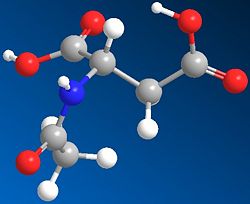Neurochemistry: Difference between revisions
imported>Pierre-Alain Gouanvic m (typo) |
imported>Caesar Schinas m (Bot: Update image code) |
||
| Line 1: | Line 1: | ||
{{subpages}} | {{subpages}} | ||
{{Image|N-ACETYL-L-ASPARTATE.JPG|right|250px|3-D view of N-acetylaspartate}} | |||
'''Neurochemistry''' is the field of biology that focuses on the chemical makeup of the brain with a particular emphasis on the metabolism of neuroactive compounds such as [[neurotransmitter]]s. [[Nerve]] cells synthesize small molecules known as neurotransmitters which are released when the cell is stimulated. The released neurotransmitters bind to [[receptor]]s on neighboring nerve cells, causing those nerve cells to be either stimulated or inhibited depending upon the type of neurotransmitter. | '''Neurochemistry''' is the field of biology that focuses on the chemical makeup of the brain with a particular emphasis on the metabolism of neuroactive compounds such as [[neurotransmitter]]s. [[Nerve]] cells synthesize small molecules known as neurotransmitters which are released when the cell is stimulated. The released neurotransmitters bind to [[receptor]]s on neighboring nerve cells, causing those nerve cells to be either stimulated or inhibited depending upon the type of neurotransmitter. | ||
Revision as of 03:52, 8 June 2009
Neurochemistry is the field of biology that focuses on the chemical makeup of the brain with a particular emphasis on the metabolism of neuroactive compounds such as neurotransmitters. Nerve cells synthesize small molecules known as neurotransmitters which are released when the cell is stimulated. The released neurotransmitters bind to receptors on neighboring nerve cells, causing those nerve cells to be either stimulated or inhibited depending upon the type of neurotransmitter.
Neurotransmitters are classified as excitatory if they stimulate other nerve cells, or inhibitory if they function to reduce activity in other nerve cells. Examples of major excitatory neurotransmitters in the brain include acetylcholine, and the amino acid glutamate. The major inhibitory neurotransmitter in the brain is gamma aminobutyric acid (GABA).
Neurochemists focus intensely on the study of how the synthesis of neurotransmitters is regulated, how neurotransmitters are released, how they act on target receptors, and then how they are inactivated. The field of neurochemistry, however, broadly includes the synthesis and metabolism of chemicals in the brain that are not involved in neurotransmission. The majority of chemicals synthesized in the brain do not act as neurotransmitters, but rather perform basic metabolic and adaptive processes necessary for normal brain function. The functions performed by many of these non-transmitter neurochemicals remain unknown. One classic example is the highly concentrated neurochemical N-acetylaspartate (NAA). NAA is the second most concentrated compound in the human brain, with glutamate being the most concentrated. Despite its high concentration in the brain, the functions performed by NAA remain uncertain and controversial. NAA is synthesized primarily by neurons in the nervous system, but currently there are no theories that account for the extremely high levels that neurons produce.
